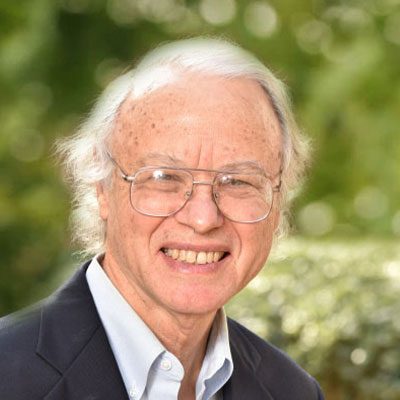
Gordon Fain
A-222B, Jules Stein Eye Institute
100 Stein Plaza, UCLA
David Geffen School of Medicine
Los Angeles, CA 90095 Jules Stein Eye Institute
100 Stein Plaza, UCLA
David Geffen School of Medicine
Los Angeles, CA 90095
Affiliations
Member, Brain Research Institute, Molecular, Cellular & Integrative Physiology GPB Home Area, Neuroscience GPB Home Area
Research Interests
Biography
A vertebrate photoreceptor uses a G-protein receptor (rhodopsin) and a G-protein cascade to produce the electrical response that signals a change in light intensity. Powerful new techniques have made it possible to understand the working of this cascade in extraordinary detail. The reason for this is that practically every protein involved in the cascade in a photoreceptor, from the pigment molecule rhodopsin to the G-protein and channels, but including also a large number of control proteins, are expressed only in the photoreceptors and nowhere else in the body. This makes it possible with genetic techniques to create mice in which these proteins have been knocked out, over or under expressed, or replaced with proteins of modified structure. We use electrical recording to study the effects of such genetic alterations on the light responses of mouse rods and cones, in order to understand the role of these proteins in the visual cascade. We are especially interested in modulatory enzymes and their function in light and dark adaptation. We also have a long-standing interest in mechanisms of photoreceptor degeneration in genetically inherited disease.
Publications
A selected list of publications:
- Chen Ching-Kang, Woodruff Michael L, Chen Frank S, Chen Yenlin, Cilluffo Marianne C, Tranchina Daniel, Fain Gordon L Modulation of mouse rod response decay by rhodopsin kinase and recoverin The Journal of neuroscience : the official journal of the Society for Neuroscience, 2012; 32(45): 15998-6006.
- Chen Jeannie, Woodruff Michael L, Wang Tian, Concepcion Francis A, Tranchina Daniel, Fain Gordon L Channel modulation and the mechanism of light adaptation in mouse rods The Journal of neuroscience : the official journal of the Society for Neuroscience, 2010; 30(48): 16232-40.
- Fain Gordon L, Hardie Roger, Laughlin Simon B Phototransduction and the evolution of photoreceptors Current biology : CB, 2010; 20(3): R114-24.
- Okawa Haruhisa, Sampath Alapakkam P, Laughlin Simon B, Fain Gordon L ATP consumption by mammalian rod photoreceptors in darkness and in light Current biology : CB, 2008; 18(24): 1917-21.
- Dizhoor Alexander M, Woodruff Michael L, Olshevskaya Elena V, Cilluffo Marianne C, Cornwall M Carter, Sieving Paul A, Fain Gordon L Night blindness and the mechanism of constitutive signaling of mutant G90D rhodopsin The Journal of neuroscience : the official journal of the Society for Neuroscience, 2008; 28(45): 11662-72.
- Fain GL Why photoreceptors die (and why they don’t), BioEssays, 2006; 28: 344-354.
- Morshedian Ala, Toomey Matthew B, Pollock Gabriel E, Frederiksen Rikard, Enright Jennifer M, McCormick Stephen D, Cornwall M Carter, Fain Gordon L, Corbo Joseph C Cambrian origin of the CYP27C1-mediated vitamin A Royal Society open science, 2017; 4(7): 170362.
- Reingruber Jürgen, Pahlberg Johan, Woodruff Michael L, Sampath Alapakkam P, Fain Gordon L, Holcman David Detection of single photons by toad and mouse rods Proceedings of the National Academy of Sciences of the United States of America, 2013; 110(48): 19378-83.
- Reingruber Jürgen, Holcman David, Fain Gordon L How rods respond to single photons: Key adaptations of a G-protein cascade that enable vision at the physical limit of perception BioEssays : news and reviews in molecular, cellular and developmental biology, 2015; 37(11): 1243-52.
- Kaylor Joanna J, Xu Tongzhou, Ingram Norianne T, Tsan Avian, Hakobyan Hayk, Fain Gordon L, Travis Gabriel H Blue light regenerates functional visual pigments in mammals through a retinyl-phospholipid intermediate Nature communications, 2017; 8(1): 16.
- Fain Gordon, Sampath Alapakkam P Rod and cone interactions in the retina F1000Research, 2018; 7: .
- Morshedian Ala, Fain Gordon L Single-photon sensitivity of lamprey rods with cone-like outer segments Current biology : CB, 2015; 25(4): 484-7.
- Morshedian Ala, Fain Gordon L The evolution of rod photoreceptors Philosophical transactions of the Royal Society of London. Series B, Biological sciences, 2017; 372(1717): 16.
- Morshedian Ala, Woodruff Michael L, Fain Gordon L Role of recoverin in rod photoreceptor light adaptation The Journal of physiology, 2018; 596(8): 1513-1526.
- Ingram Norianne T, Sampath Alapakkam P, Fain Gordon L Why are rods more sensitive than cones? The Journal of physiology, 2016; 594(19): 5415-26.
- Morshedian Ala, Fain Gordon L Light adaptation and the evolution of vertebrate photoreceptors The Journal of physiology, 2017; 595(14): 4947-4960.
